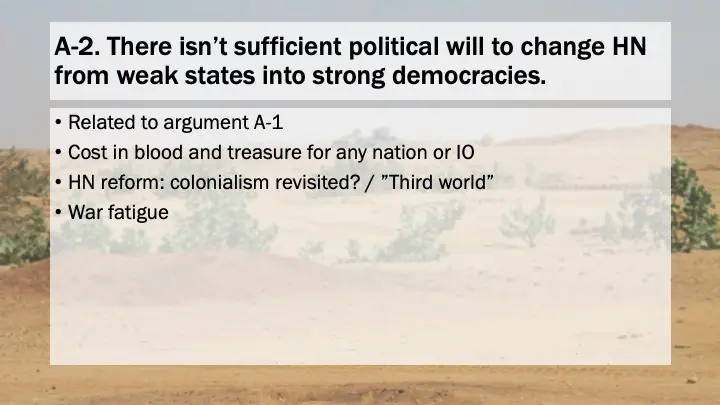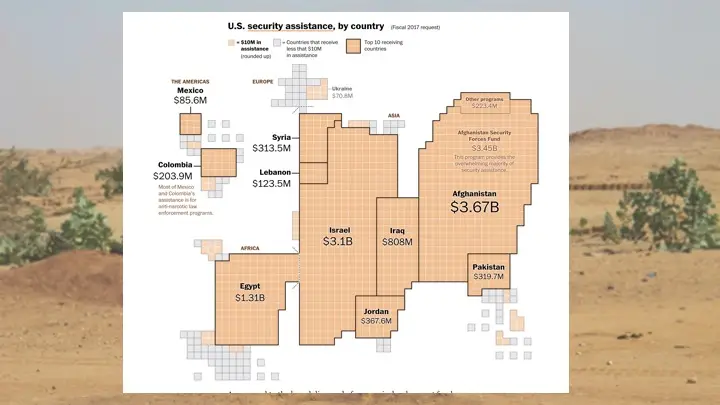The deaths of four special operators in Niger late last year introduced the public US military activity in the African Sahel.[efn_note]Searcy, Dionne, Helene Cooper, and Eric Schmitt. 2017. “Conflicting Accounts in Niger Ambush Are Subject of Pentagon Investigation.” The New York Times.[/efn_note] This band of semi-arid flat land between the Sahara and savannah stretches from Africa’s Atlantic coast across to the Red Sea. It is home to an interlocking network of insurgencies, drug and human trafficking, and terrorist activity.[efn_note]Shurkin, Michael, Stephanie Pezard, and S. Rebecca Zimmerman. 2017. Mali’s Next Battle. Santa Monica, CA: RAND[/efn_note] US and French military operations center around flashpoints in northern Mali, Niger, and parts of Chad since Boko Haram’s activity moved there from northeast Nigeria. Mauritania and Burkina Faso receive less attention, and the Sudan, while geographically Sahelian is often treated alone. The most significant counter-force to Trans-Sahelian destabilization has been led by the EU through the French, but anti-terror mission of the United States have forced it to respond to the rise of groups like AQIM, Al-Shabab and Boko Haram.[efn_note]Campbell, John, and J. Peter Pham. 2014. Does Washington Have a Stake in the Sahel? January 10.[/efn_note] Africa is the only continent to have its own combatant command: US Africa Command (AFRICOM). Analysis of the regions insurgency problems consistently suggest that only a comprehensive COIN effort that takes into consideration deep understanding of local, and regional political complexities is viable. No better strategy than COIN matches the complex matrix of problems that currently beset the region. On the other hand, the scope of its requirements make it difficult to support, difficult to enact, and difficult to conclude.[efn_note]Shurkin, Michael, Stephanie Pezard, and S. Rebecca Zimmerman. 2017. Mali’s Next Battle. Santa Monica, CA: RAND[/efn_note] Unfortunately, for the foreseeable future, the states of the Sahel are unlikely to see a true Western-led counterinsurgency campaign. AFRICOM’s security strategy should remain tightly focused on supporting European-led programs with logistical, intelligence and materiel support until there is more domestic US support for a comprehensive COIN approach.
Whole-of-Government Unwelcome in Africa
Section 1-40 through 1-76 of the 2014 edition of FM 3-24 MCWP 3-33.5 Insurgencies and Countering Insurgencies (COIN Manual or FM 3-24) describe a “whole-of-government” approach to COIN.[efn_note]United States Army. 2014. FM 3-24, MCWP 3-33.5 Insurgencies and Countering Insurgencies. Washington DC: US Government.[/efn_note] In order for a host country to achieve legitimacy in the eyes of the population, the manual argues that the local government must be supported and trusted by the population as their primary source of security and prosperity. In order to achieve this COIN requires the participation of US foreign policy agencies such as the State Department, USAID, or other agencies needed to support and secure the population, and then to build comparable capacity into the host nation. This suggests a significant commitment on behalf of non-DOD partners and that they then successfully create the simulacra of themselves in manner consistent with the local social norms. While the US has managed to bring sufficient effort from non-DOD agencies to bear in standing-up Iraq, the same cannot yet be said for Afghanistan. The Sahel poses problems much more like the Afghanistan than Iraq. The Malian government’s turn toward democracy in 2012 was notably undermined by US-trained “Green Berets” who ousted the democratically elected leader. Efforts by the US, France, or EU have been insufficient in creating political stability in the region, much less economic stability. The NATO-led UN intervention that toppled Muamar Qaddafi resulted in an unfortunate, if not avoidable surge of new violent extremists into the Sahel after 2012. A large and sustained presence of US government personnel, military or otherwise has so far been unwelcome in Africa, and US AFRICOM has spent years actively assuaging local leaders fears of a “militarized” US foreign policy for the region.[efn_note]Brown, David E. 2013. “AFRICOM at 5 Years: The Maturation of a New U.S. Combatant Command.” Strategic Studies Institute. August 8.[/efn_note] The colonial legacy of the region has kept France in-country and drives their own COIN strategy. An Iraq or Afghanistan-style surge of US troops would likely be seen around the world as unsavory neo-colonialism. However, without a much larger presence of State Department, USAID and other agencies to help countries like Mali and Niger create lasting stable governance across the region, those areas not under central government control will inevitably turn to more local power players such as the local warlords, nomadic Tuaregs, and smugglers who perpetuate internecine struggle that allow terrorist organizations to thrive. COIN, by the book, may be impossible in the Sahel.
US Lacks Political Will to Stabilize Region
The US does not seem sufficiently interested the levels of insurgent, criminal or terrorist activity to warrant pan-Sahel COIN. Economic interest and investment opportunity for US firms is negligible. Terrorist groups that recruit here may be allied in name with international groups like Al-Qaeda or swear allegiance to ISIS, but rarely appear to have real intercontinental reach. Tons of narcotics moved through the area in the last two decades but has been largely destined for Europe. Problematic migration and human smuggling operations route north through Libya, but the primary US response has been little more than the stalled but controversial immigration policy.[efn_note]Offner, Fabien. 2018. A dozen shades of khaki: counter-insurgency operations in the Sahel. January 11.[/efn_note] Africa’s colonial history and physical proximity to Europe makes it the likely first market for drugs, criminal enterprise and terror, and accordingly the most convenient source for stabilization forces.
The level of spending by the US on the region is another indicator of political will. The US recently committed $60 million to the new G5 Sahel collective security project.[efn_note]France Diplomatie. 2018. G5 Sahel Joint Force and Alliance for the Sahel. January. [/efn_note] Other funding, always in the millions of Euros comes from the EU, Saudi Arabia and the UAE. Between 2005 and 2013 the US provided Mali, Chad, Mauritania and Niger less than $250 million through the Trans-Saharan Counterterrorism Project.[efn_note](Searcy, Searcy, Dionne, Helene Cooper, and Eric Schmitt. 2017. “Conflicting Accounts in Niger Ambush Are Subject of Pentagon Investigation.” The New York Times.[/efn_note] Compare this to the $1.3 trillion it spent on COIN in Iraq and Afghanistan over the same period, or the $11 million the spent per day countering ISIS in 2015.[efn_note]McCarthy, Niall. 2015. The Cost of Fighting ISIS Compared To Iraq & Afghanistan. December 14.[/efn_note]
Recommendation
The current administration has signaled little interest in traditional approaches to African development or security. Counter-terror and counterinsurgency efforts, especially as articulated in the COIN manual exist on a continuum from strictly military, squad-sized, one-time, special operations to multi-year, interagency, security assistance and nation-building campaigns. The US should keep its operations sized towards the former over the latter. Beyond the arming of drones to be launched from AFRICOMs new base in Niamey Niger, the presence of US military and diplomatic personnel in the region is minimal and should remain so for the immediate future. European and UN-led efforts are more comprehensive in their design and appear to be taken more seriously as a part of their foreign policy or national security strategies.[efn_note]Thomas, Charles G. 2016. The U.S. can’t fight terrorists in Africa. So guess what it does instead. Washington Post. February 1.[/efn_note] The US capacity to provide material, logistics, intelligence and extensive financial support would be better spent supporting European-led efforts, as the local population is already more familiar with them and they are more likely to see long-term comprehensive COIN operations in their national interest.














